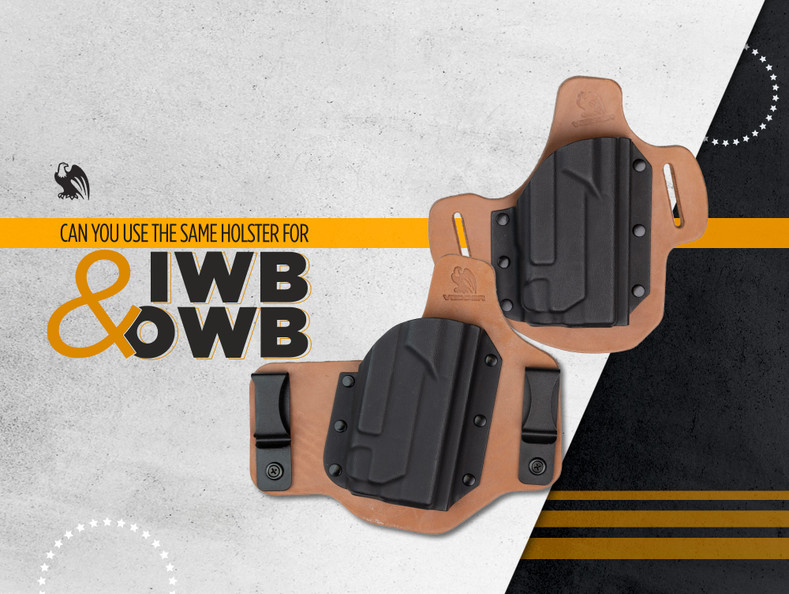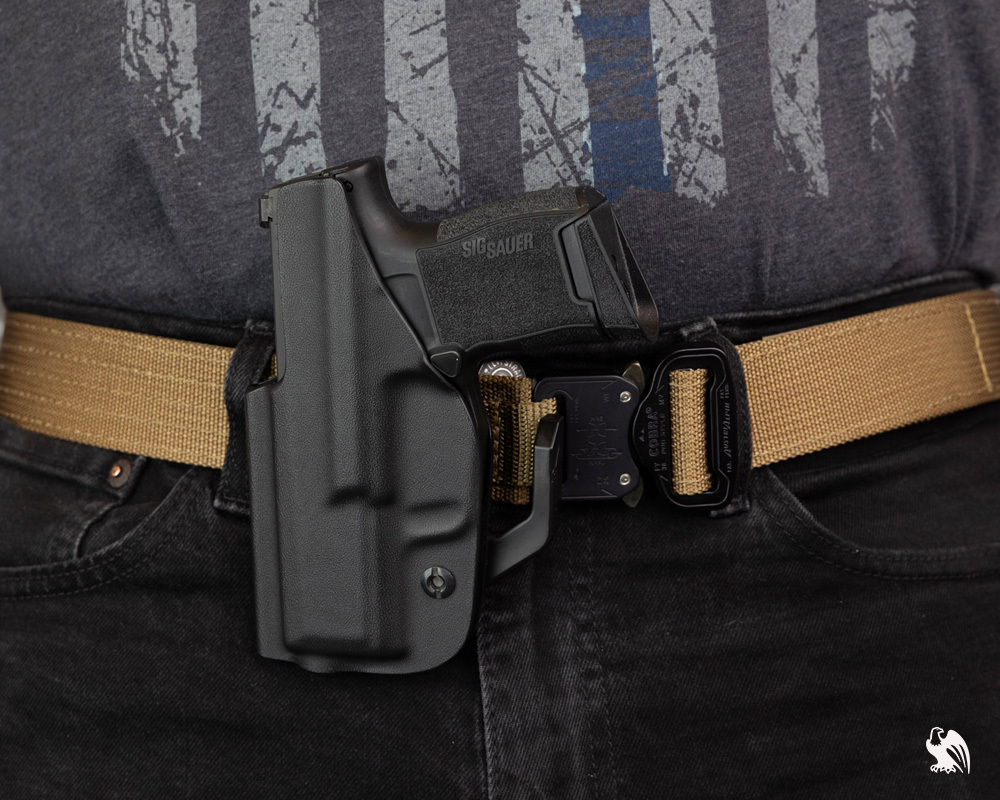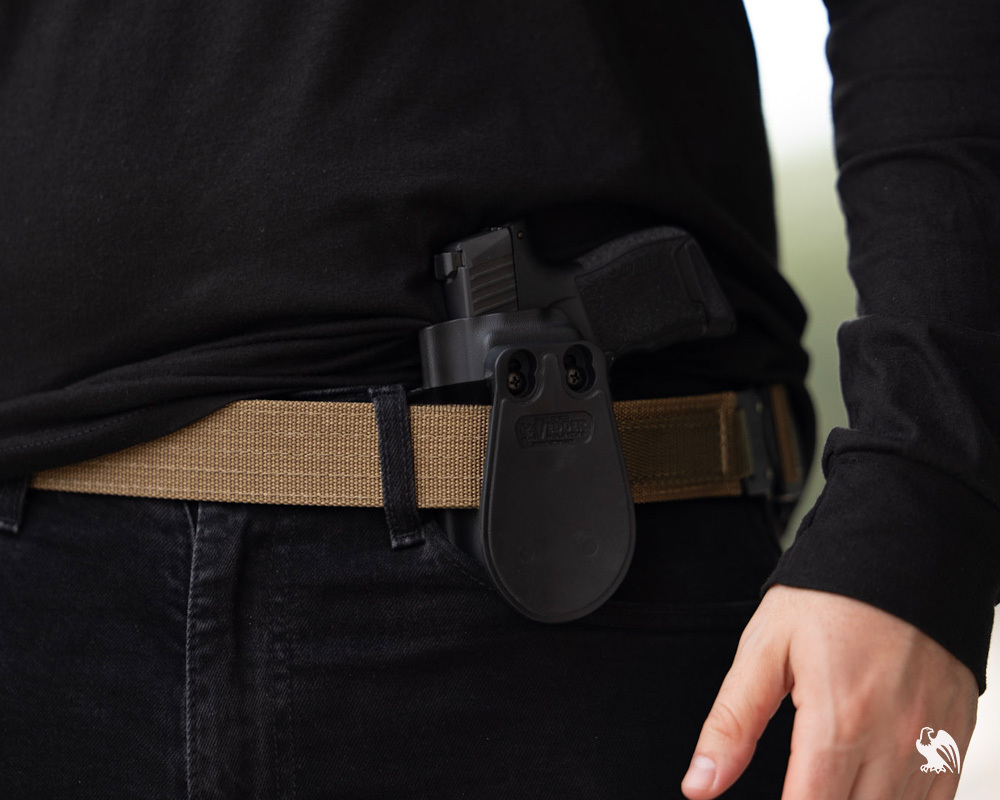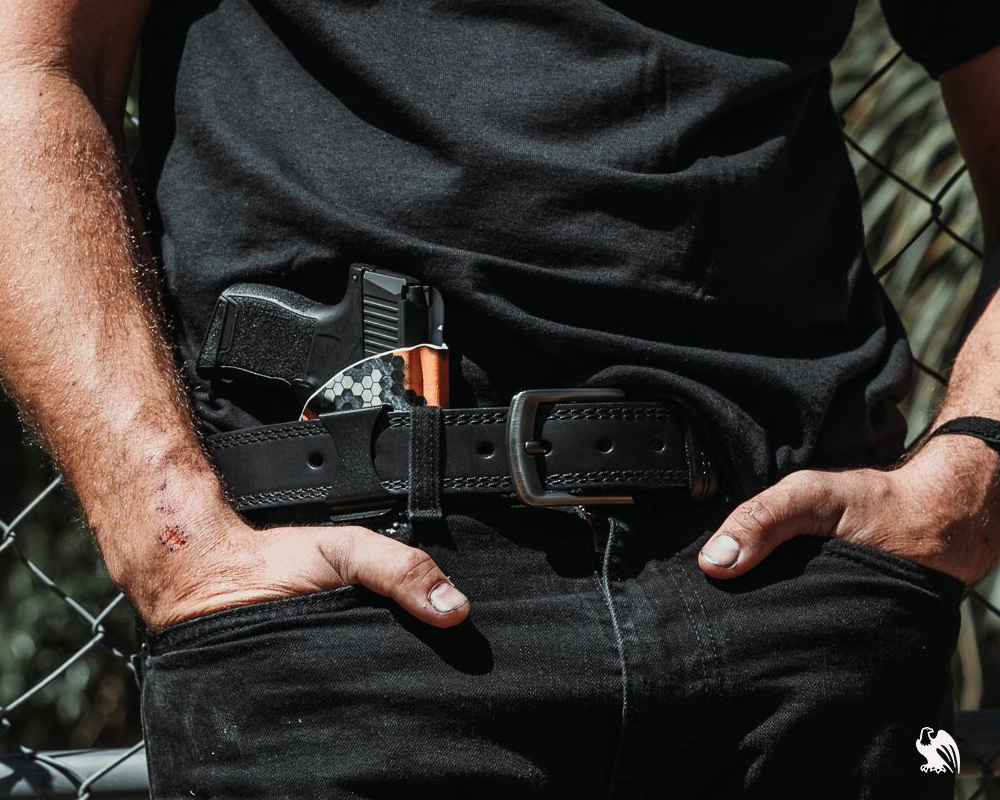Can You Use The Same Holster For IWB And OWB Carry?

With so many holster styles available on the market, it’s reasonable to wonder if it’s really necessary to buy two separate holsters when switching between inside and outside the waistband carry, or whether you can use one holster interchangeably. After all, they look similar enough; how different could they be?
As tempting as it may be to try to use the same holster for both IWB and OWB carry, it’s better to use one specifically designed for the job. Most clips and holster shells are designed to be worn either IWB or OWB and may be impractical or impossible to use otherwise. Even if you do manage to switch between the two, using the wrong holster can result in discomfort, printing, or a hindered draw.
In this article, we’ll cover all the differences that make IWB and OWB holsters unique, and discuss the importance of using the right holster for the position you’re carrying in.
What is the Difference Between IWB and OWB Holsters?

Although inside the waistband and outside the waistband holsters are both carried along your waistline, they are drastically different in terms of design. Both styles are excellent for concealed carry and are equally functional regarding security, ease of draw, and adjustability. However, the differences between the two are significant enough that they can’t be used interchangeably.
One of the biggest differences between IWB and OWB holsters is their clips.
IWB holsters, which are worn inside the waistband of your pants, are fixed with clips that wrap around the outside of your belt. With the shell of your holster tucked securely in between your body and waistband, the clips are the only part of the holster that is visible while worn.
OWB holsters, on the other hand, which are worn on the outside of your pant waistband, are secured to your belt with either clips or loops. Clip-style OWB holsters come with a clip that wraps around the inside of your belt, while loop-style OWB holsters require you to thread your belt through them to hold everything in place.
Another major difference between these holster styles is the shell itself. Although some of these shells are pretty similar, there are some subtle but important differences that are not immediately apparent.
For example, the shells on our IWB LightTuck® and OWB ProDraw® appear nearly identical at first glance. But when you look a little closer, you can see there are different impressions, or “channels,” molded into the Kydex. These channels are strategically placed in areas where hardware is installed. The indentations ensure that your gun never comes into contact with said hardware when it is drawn and holstered. So, if you were to swap an IWB clip to an OWB clip and vice versa, the hardware would no longer be within these channels and would seriously scratch up your pistol.
Additionally, many holster styles feature curved designs or leather backings that are designed to contour to your body’s natural curves. When worn facing the wrong direction, these shells will protrude from your body and be visible under your clothes.
Our IWB ComfortTuck® and OWB Quick Draw holsters, for example, both feature an FBI-canted shell and a leather backing. But if you were to try to flip the ComfortTuck® around to wear it outside the waistband, the leather backing would now be facing outward, while the shell and clips would be facing inward. At that point, you may as well call it the “DiscomfortTuck.”
Now that we’ve covered the differences between these holster styles, let’s take a deeper look at the potential drawbacks of wearing an IWB holster outside the waistband, and vice versa.
Can You Carry an IWB Holster OWB?

Looking at the design of an inside the waistband holster, you may think it would be easy enough to use that clip on either side of your belt. But while you technically can secure an IWB holster to the outside of your waistband, it won’t function as well as you might hope.
IWB clips are designed to hook around the outside of your belt, keeping the holster in place between your pant waistband and body. If you were to turn your holster around and hook the clip around the inside of your belt with the shell on the outside of your waistband, your right-handed holster would now be a left-handed holster and vice versa. It would also dangle loosely off your waistline and might flop around when you walk, as IWB holsters need the pressure of being pressed between your pants and body to be secured.
Not only would this be annoying, but you would run the risk of your gun and holster smacking into things or falling off your waistline, creating a dangerous situation. It would also make drawing your weapon slower and more difficult, as you wouldn’t have the stability you would normally.
But if the clip is the problem, couldn’t these issues be solved by swapping the IWB clip for an OWB clip?
You could change the clip on your holster, but it would require you to make some alterations. Your holster is molded with channels and drilled with holes in specific places to accommodate an IWB clip. If you were to drill new holes in new places to fit an OWB clip, the hardware would no longer be aligned with the molded channels and would badly scratch your weapon.
And to make matters worse, the extra holes you would need to drill to install a different clip make it easier for external dirt and debris to access your firearm, which is always something to avoid.
Can You Carry an OWB Holster IWB?

OWB holsters are different from IWB holsters in that many of them are actually impossible to wear inside the waistband. The majority of OWB holsters are secured to your belt using loops cut into a hybrid backing, like our Quick Draw, or with loop-style clips through which your belt is threaded, like our LightDraw®. So, unless you’re wearing your belt on the inside of your waistband somehow, this style of holster would be impossible to wear IWB.
OWB holster styles that feature a conventional clip would technically be possible to secure inside your waistband, but the result would be uncomfortable and difficult to conceal. For example, our ProDraw® holster features a paddle-style clip that allows you to put it on and take it off without removing your belt. However, the clip has a curved design that’s meant to form around the body’s natural curves when worn outside the waistband. Worn inside the waistband, this curve would protrude outward away from your body, making it nearly impossible to wear without printing.
Also, because the shell is designed for either a right- or left-hand draw when worn OWB, if you turned it around to wear it IWB, it would now be a left- or right-handed holster, respectively. To solve this problem, you could drill holes in the other side of the holster and move the clip, but then the hardware would no longer be aligned with the molded channels and would scratch your gun. Plus, you’d have holes in your holster that could allow dirt and debris to access your firearm.
The Importance of Using the Right Holster for the Job

Although it may sound simpler to have one holster you can wear in both positions, in reality, using an IWB holster OWB and vice versa just isn’t a practical solution. These holsters are designed with a specific purpose, and deviating from that can result in printing, discomfort, or worse — an unsecure and potentially dangerous situation. For all those reasons and more, we do not recommend making alterations to your holster or wearing it in a position it’s not designed for.
You may have seen “modular holster” designs that are marketed as a one-stop solution for all your carry needs. These holsters allow you to swap their clips and configuration so they can be carried in different positions and for both right- and left-handed use. As efficient as these may sound, the unfortunate truth is that while they can operate in every carry position, they don’t perform well in any of them. These holsters tend to be more bulky when carried IWB, and their shells aren’t designed to naturally fit with any specific part of your body. Not only that, but these holsters tend to have numerous holes in their shells to allow for swapping and moving of clips, allowing the aforementioned dirt and debris to access and contaminate your weapon.
Rather than use a holster that performs okay in a variety of carry positions, it’s far better to find a holster that does one thing exceptionally. Fortunately, most of our designs here at Vedder Holsters are compatible with a variety of carry positions. Our LightTuck®, for example, is our most versatile IWB holster and can be carried in any position along the waistline. Our OWB ProDraw® is also easy to wear in most positions, and both holsters are highly adjustable to help you find that “sweet spot” of comfort and concealment.
Because our holsters are so versatile, many people find that having one IWB and one OWB holster for their pistol is sufficient if they tend to switch between positions. The most important thing is finding a holster that accommodates your specific needs and preferences. If you’re not sure which holster is right for you, take a look at our interactive Holster Comparison Tool to help you find the right fit.
Ready to invest in a reliable, custom-fit holster? Visit our Holsters by Gun Model page to find Kydex holsters tailored to your firearm. Plus, explore our Resources Page for gear recommendations, concealed carry guides, and exclusive content to elevate your carry system.
